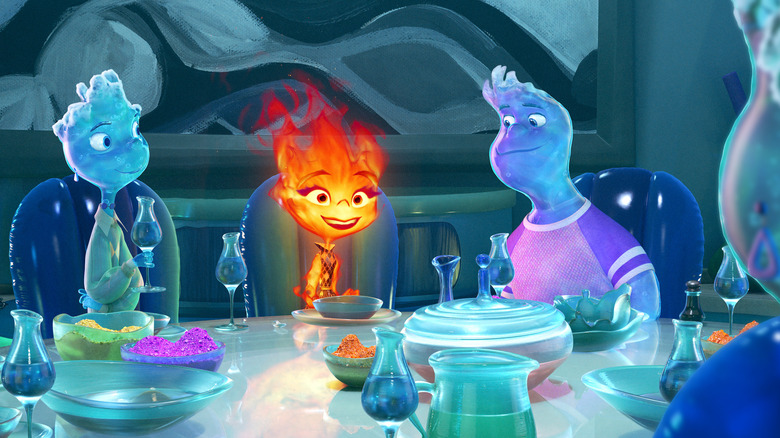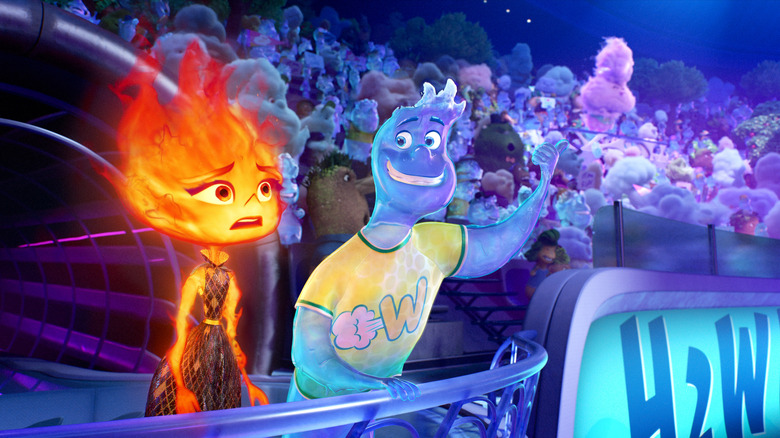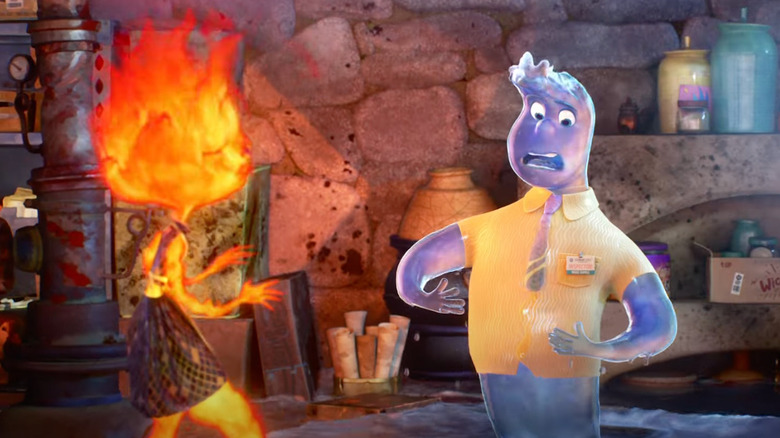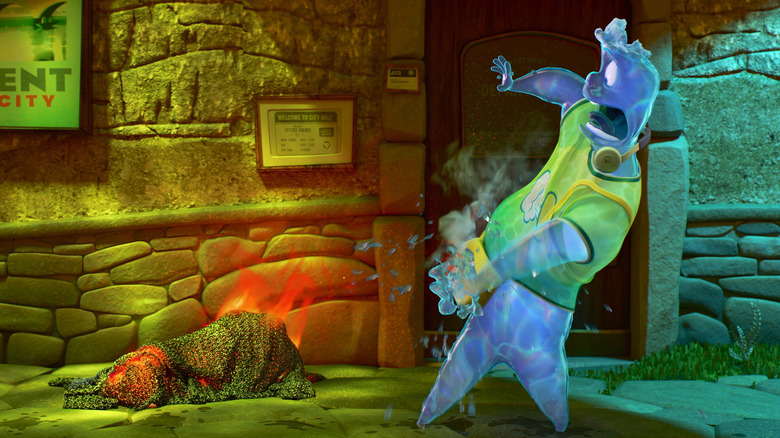Pixar's Elemental Had A Particularly Difficult Time Creating Water Characters
Pixar's new movie "Elemental" (read our review here) may seem like a simple story on the surface. Many even think it borders on being retreads of "Inside Out" or "Zootopia," just with characters made up of earth, air, water, and fire. But there's a powerful story of belonging at the center of it, one that's inspired by the true story of director Pete Sohn's parents and their immigration to the United States from Korea but has even larger implications bubbling beneath the surface for a variety of marginalized people. At the same time, there's literal bubbling thanks to the presence of lead character Wade (Mamoudou Athie), who is made of water, and his potentially romantic relationship with a fire woman called Ember (Leah Lewis). In fact, the properties of water proved to be quite challenging when it came to bringing Wade to life, which was rather surprising to the filmmakers.
During a press conference at Pixar Animation earlier this year, Pete Sohn and producer Denise Ream spoke to /Film and other members of the media about the making of the movie. The two filmmakers agreed that their initial concerns were focused on animating Ember and her fire body rather than Wade and his body of water. But despite having animated water at Pixar for years, even setting movies like "Finding Nemo" and "Finding Dory" almost entirely in the ocean, they quickly learned that animating Wade and the various water characters in the movie proved to be much more challenging than they anticipated.
'We all knew fire would be hard, but I think we were a little surprised about the water characters being so difficult'
During the press conference, Sohn asked members of the media, "If you were to bet, let's go back five years and we take all of you, and then you would bet which character would be harder, fire or water?" When many confirmed that fire sounded like the more difficult task, Sohn agreed:
"I thought the same exact thing. And it was hard to get [Ember] to a certain place, but water, because of its refractiveness, because of its transparency — per shot — and Wade's design of his landscape, that mouth going everywhere, eyeballs going everywhere – Even last week, there was still [a moment], I'm seeing the back of his teeth through the back of his head or whatever it is. And water became the hardest one, surprisingly."
Ream reaffirmed that sentiment, adding that animating Wade was the "biggest challenge" they faced during production. She said, "We all knew fire would be hard, but I think we were a little surprised about the water characters being so difficult."
'So many versions, each learning from the last and applying the ideas to the next'
So what made animating water so challenging? Though fire and water are diametrically opposed to each other, they both posed similar problems for the animators of "Elemental." Sanjay Bakshi, the visual effects supervisor for the film, explained in a behind-the-scenes presentation at Pixar Animation:
"Fire is too dynamic. The clues for water are only when it's in motion. So we sprinted. Every three weeks we challenged ourselves to come up with a new version of Ember. So many versions, each learning from the last and applying the ideas to the next. We did the same thing for Wade, starting with more realistic water and slowly tuning the balance between realism and stylization."
The first time watching "Elemental," you might not notice some of the more subtle aspects of how fire and water were animated as characters. In the case of Wade (and other water characters), sometimes his movement will result in his limbs coming and going, as his body temporarily absorbs the moving water. Other times, you'll notice a water ripple on Wade's cheek, or his head detaching entirely from his body as he makes a quick movement.
'Without these, Wade would actually feel more like glass than water'
Furthermore, water (and fire) leaves a trail behind it. Typically, this is something the effects department would handle on its own, but with "Elemental," the animation department needed to direct and stylize those details in order to enhance the character performances.
Stephen Marshall, the effects supervisor for character effects (which means helping develop and deliver the effects for all fire, water, and air characters on the movie), explained that the effects really needed to enhance Wade's appearance as water, which included "well-timed splashing and looseness" as well as "control over busyness," and that required splitting up the various effects for Wade into layers. Marshall said:
"Because water is very difficult to control, we don't allow too much dynamics across Wade's body, and any special big water effects like tears or crying are handled separately and were handcrafted by our effects artists to always support the performance ... We use smaller water effects like ripples, droplets, and jiggle to keep Wade's surface active. Without these, Wade would actually feel more like glass than water. Anything bigger was always handcrafted and used to support the story."
As directing animator Gwendolyn Enderoglu also pointed out, "Water is a much heavier force that retains its volume and mass. So that downward gravity made Wade more grounded in his contact and it gave it lots of fun and playful opportunity for sloshy watery overlap." This prompted animation supervisor Kureha Yokoo to challenge their animators to think about how a human would perform an action versus how fire or water would perform the same action. Alison Rutland, another directing animator on the film, added, "Animators referenced videos of water balloons to think of how Wade's internal water volume might flow between poses."
A delicate balance between physics logic and cartoony appeal
Examples of alternate versions of Wade were shown during the presentation, including those that resembled glass instead of water. That's why a combination of realistic and stylized animation was required to bring both water and fire to life in Wade and Ember. While both behave with many of the scientific properties of water and fire, in the end, their look has been enhanced when needed to support the story and look of "Elemental." As production designer Don Shank put it, the movie strikes "a delicate balance between physics logic and cartoony appeal." Wade and Ember needed to have the "real visceral impact of fire and water," but they also had to be "clear and readable for the storytelling."
If you're looking for a more statistical explanation as to what made Wade (and Ember) significantly more difficult to animate than your average computer animated character from Pixar, Enderoglu laid it out:
"A typical Pixar rig has about 4,000 controls and [technical director] Jeremy [Heintz] highlighted many of the new tools and controls that we added and these really did add up. Ember and Wade had roughly 10,000 individual animation controls each. So the animators really had a robust toolbox for every shot's unique needs, exaggerated or subtle."
The result is some of the most stunning animation Pixar Animation has ever produced, though it might take a few viewings of "Elemental" to truly appreciate it all.
"Elemental" arrives in theaters on June 16, 2023.




